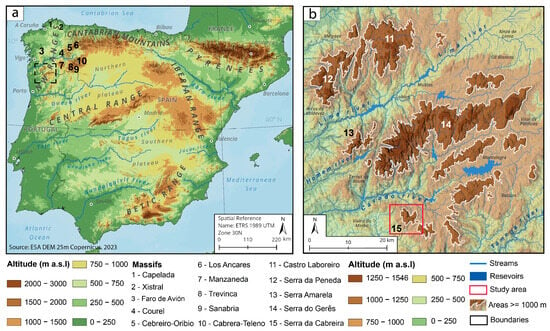Journal Description
Quaternary
Quaternary
is an international, peer-reviewed, open access journal that covers all aspects within quaternary science, embracing the whole range of scientific fields related to geological, geographical, biological, physical, chemical, environmental and human sciences. The journal is published quarterly online by MDPI.
- Open Access — free for readers, with article processing charges (APC) paid by authors or their institutions.
- High Visibility: indexed within Scopus, ESCI (Web of Science), GeoRef, and other databases.
- Journal Rank: CiteScore - Q2 (Earth and Planetary Sciences (miscellaneous))
- Rapid Publication: manuscripts are peer-reviewed and a first decision is provided to authors approximately 38.9 days after submission; acceptance to publication is undertaken in 11.6 days (median values for papers published in this journal in the first half of 2025).
- Recognition of Reviewers: reviewers who provide timely, thorough peer-review reports receive vouchers entitling them to a discount on the APC of their next publication in any MDPI journal, in appreciation of the work done.
- Journal Cluster of Geospatial and Earth Sciences: Remote Sensing, Geosciences, Quaternary, Earth, Geographies, Geomatics and Fossil Studies.
Impact Factor:
2.1 (2024);
5-Year Impact Factor:
2.3 (2024)
Latest Articles
Late Pleistocene Low-Altitude Atlantic Palaeoglaciation and Palaeo-ELA Modelling: Insights from Serra da Cabreira, NW Iberia
Quaternary 2025, 8(4), 71; https://doi.org/10.3390/quat8040071 (registering DOI) - 1 Dec 2025
Abstract
►
Show Figures
Low-altitude palaeoglaciation in Atlantic mountain regions provides important insights into past climatic conditions and moisture dynamics during the Last Glacial Cycle. This study presents the first quantitative reconstruction of palaeoglaciers in Serra da Cabreira (northwest Portugal), a mid-altitude granite massif located along the
[...] Read more.
Low-altitude palaeoglaciation in Atlantic mountain regions provides important insights into past climatic conditions and moisture dynamics during the Last Glacial Cycle. This study presents the first quantitative reconstruction of palaeoglaciers in Serra da Cabreira (northwest Portugal), a mid-altitude granite massif located along the Atlantic fringe of the Iberian Peninsula. Detailed geomorphological mapping (1:14,000) and field surveys identified 48 glacial and periglacial landforms, enabling reconstruction of two small valley glaciers in the Gaviões and Azevedas valleys using GlaRe numerical modelling. The spatial distribution of palaeoglacial landforms shows a pronounced west–east asymmetry: periglacial features prevail on wind-exposed west-facing slopes, whereas glacial erosion and depositional landforms characterise the more protected east-facing valleys. The reconstructed glaciers covered 0.24–0.98 km2, with maximum ice thicknesses of 72–89 m. Equilibrium-line altitudes were estimated using AABR, AAR, and MELM methods, yielding consistent palaeo-ELA values of ~1020–1080 m. These results indicate temperature depressions of ~6–10 °C and enhanced winter precipitation associated with humid, Atlantic-dominated conditions. Comparison with regional ELA datasets situates Cabreira within a clear Atlantic–continentality gradient across northwest Iberia, aligning with other low-altitude maritime palaeoglaciers in the northwest Iberian mountains. The findings highlight the strong influence of the orographic barrier position, moisture availability, valley hypsometry, and structural controls in sustaining small, climatically sensitive glaciers at low elevations. Serra da Cabreira thus provides a key reference for understanding Last Glacial Cycle palaeoclimatic variability along the Western Iberian margin.
Full article
Open AccessArticle
The Late Quaternary Aeolian Deposits in the Subtropical Bose–Bubing Basins, Southern China
by
Jiemei Zhong, Ping Lai, Wei Liao, Zhongping Lai, Christopher J. Bae, Wei Wang and Jef Vandenberghe
Quaternary 2025, 8(4), 70; https://doi.org/10.3390/quat8040070 (registering DOI) - 28 Nov 2025
Abstract
►▼
Show Figures
Aeolian deposits are globally recognized as sensitive recorders of Quaternary climate and environmental change, exemplified by the continuous loess sequences of the Chinese Loess Plateau in northern China, which document paleoclimatic and paleoenvironmental evolution since the Miocene. However, such deposits have rarely been
[...] Read more.
Aeolian deposits are globally recognized as sensitive recorders of Quaternary climate and environmental change, exemplified by the continuous loess sequences of the Chinese Loess Plateau in northern China, which document paleoclimatic and paleoenvironmental evolution since the Miocene. However, such deposits have rarely been confirmed in low-latitude inland regions of southern China. Here we present systematic evidence of aeolian deposition in a low-latitude environment, namely at the Xinlipoding (XLPD) Paleolithic site, situated between the Bose and Bubing Basins in Guangxi, southern China. Using optically stimulated luminescence (OSL), geochemical, and grain-size analyses, we investigate 100 cm thick yellow-brown sandy loam exposed on the hillside of the Bubing Basin. OSL dating constrains its accumulation between 25.3 ± 1.5 ka and 2.7 ± 0.1 ka, spanning the Last Glacial Maximum (LGM) to the late Holocene. Geochemical signatures indicate that the sediments were primarily derived from a nearby terrace in the Bose and Bubing Basins. Grain-size end-member modeling further reveals a mixed alluvial-aeolian origin, comprising both windblown and reworked loess. These findings demonstrate that aeolian dust deposition persisted even in the humid subtropical low-latitude regions of China, recording continuous dust input across glacial–interglacial cycles. The XLPD section thus provides a valuable framework for reconstructing late quaternary environmental change and extends the spatial reach of global aeolian deposition into previously underrecognized regions. Importantly, it also offers a crucial paleoenvironmental context for human occupation in the Bubing Basin from the LGM through the late Holocene.
Full article

Figure 1
Open AccessArticle
Holocene and Late Pleistocene Flood Events in Central Europe Reconstructed from Eifel Maar Lake Sediments
by
Johannes Albert and Frank Sirocko
Quaternary 2025, 8(4), 69; https://doi.org/10.3390/quat8040069 - 18 Nov 2025
Abstract
►▼
Show Figures
Severe floods such as in the Ahr valley in July 2021 are one of the leading causes of fatalities from natural disaster. Riverine and lacustrine floods are caused by a sudden flux of water masses from heavy rainfall or snowmelts. These surface water
[...] Read more.
Severe floods such as in the Ahr valley in July 2021 are one of the leading causes of fatalities from natural disaster. Riverine and lacustrine floods are caused by a sudden flux of water masses from heavy rainfall or snowmelts. These surface water runoff events significantly enhance erosion of detrital material in the catchment, which is then deposited in natural sinks such as lakes. We reconstructed flood phases from Eifel maar lakes over the last 60,000 years and compared flood behavior with regional riverine flood data covering the past 1000 years. Multi-centennial flood cycles persisted throughout the Holocene with durations of flood-poor periods significantly decreasing around 3700 years ago due to human activity in the Eifel region. Holocene flood frequency peaked in the 13th and 14th centuries during the medieval agricultural revolution. Late Pleistocene flood phases occurred during the Younger Dryas and Heinrich stadials and represent surface runoff events in cold and dry climates. As flood behavior is strongly affected not only by increased water supply but also by soil stability and erosion processes in the catchment area, flood phases reflect shifts in the prevailing climate conditions and vegetation cover, either through natural steppe formation or human impact.
Full article

Figure 1
Open AccessArticle
North American Caballines and Amerhippines of the Past 1 Million Years (Part 1)
by
Véra Eisenmann, Christina I. Barrón-Ortiz and Marisol Montellano-Ballesteros
Quaternary 2025, 8(4), 68; https://doi.org/10.3390/quat8040068 - 14 Nov 2025
Abstract
►▼
Show Figures
Horses were widely distributed in North America during the Pleistocene epoch and their fossil remains are common in sedimentary deposits of this age. Despite their rich fossil record, the systematics and taxonomy of North American Pleistocene horses remain unresolved. We evaluated a large
[...] Read more.
Horses were widely distributed in North America during the Pleistocene epoch and their fossil remains are common in sedimentary deposits of this age. Despite their rich fossil record, the systematics and taxonomy of North American Pleistocene horses remain unresolved. We evaluated a large sample of cranial and postcranial horse fossils of Irvingtonian and Rancholabrean North American Land Mammal Age. In this study, we present Part 1 of our evaluation, which centers on caballine horses, Equus (Equus). We present data (measurements and photographs) and analyses (Simpson’s ratio diagrams, scatter diagrams, and anatomical comparisons) that reveal morphological variation in North American caballine horses. These analyses serve as the basis for recognizing different morphospecies: E. (E.) scotti, E. (E.) alaskae, E. (E.) lambei (the latter two possibly representing “ecological variants” of a single species), E. (E.) niobrarensis, E. (E.) pacificus, and E. (E.) complicatus. How these morphospecies (or chronospecies or ecological variants) were phylogenetically related remains to be evaluated. Equus (E.) hatcheri may be considered as a morphological variant or chronological variant of E. (E.) niobrarensis. Equus holmesi is considered a junior synonym of E. (E.) scotti, while E. bautistensis may be regarded as a junior synonym of E. (E.) pacificus. Equus laurentius is a junior synonym of E. (E.) caballus, a synonymy proposed previously in other studies. We are uncertain about the nature of E. midlandensis. In addition, we identify morphometric and anatomical features that distinguish between Equus (Equus), North American Equus (Amerhippus), and Equus (Hesperohippus) mexicanus. This study aims to advance our understanding of the taxonomy of North American Pleistocene horses, providing a thoroughly documented catalogue as a basis for further studies.
Full article

Figure 1
Open AccessArticle
3D Modeling of Rock-Cut Monuments with Astronomical Elements Using Aerial Photogrammetry
by
Penka Maglova, Alexey Stoev, Ognyan Ognyanov and Mina Spasova
Quaternary 2025, 8(4), 67; https://doi.org/10.3390/quat8040067 - 13 Nov 2025
Abstract
►▼
Show Figures
This report presents the advantages of using drone-photographic scanning technology as a method for creating 3D documentation and 3D databases of rock-cut monuments with astronomical elements. Through this modern technology, together with specialized equipment and software, we have the advantage of obtaining a
[...] Read more.
This report presents the advantages of using drone-photographic scanning technology as a method for creating 3D documentation and 3D databases of rock-cut monuments with astronomical elements. Through this modern technology, together with specialized equipment and software, we have the advantage of obtaining a digital 3D model of the terrain and the existing archeological sites there. A procedure for digitizing the physical space of rock-cut monuments using integrated technology, in accordance with the standard for such sites, is shown. The data is stored in distributed databases. The digital space provides an opportunity to connect the monument with the celestial sphere, the main movements of the luminaries (Sun, Moon, and bright planets), and specialized astronomical software. Using the 3D modeling method, two Bulgarian rock-cut monuments were studied: the Belintash rock sanctuary near the village of Mostovo in the municipality of Asenovgrad and the cromlech near the village of Dolni Glavanak in the municipality of Madzharovo. It can be seen that the modeling of real archaeoastronomical concepts and the connections between the morphological elements of the monuments and the notable objects in the sky have been proven with a high degree of reliability. For example, rock outcrops and pillars are associated with sunrises and sunsets during the solstices and equinoxes.
Full article

Figure 1
Open AccessArticle
Paleoenvironments of the Last Interglacial–Glacial Transition on the East European Plain: Insights into Climate-Driven Ecosystem Dynamics
by
E. Ershova, S. Kuzmina, S. Sycheva, I. Zyuganova, E. Izumova, A. Zharov, V. Yu. Kuznetsov, F. Maksimov, S. Kolesnikov, N. Lavrenov and E. Ponomarenko
Quaternary 2025, 8(4), 66; https://doi.org/10.3390/quat8040066 - 11 Nov 2025
Abstract
►▼
Show Figures
A multiproxy study of a new Pleistocene locality at Ivantzevo, Moscow Region, was conducted to reconstruct paleoenvironments from the Middle Pleistocene to the Last Pleniglacial. Lacustrine deposits and peat accumulated in a wetland within a fluvioglacial depression formed during the Dnieper–Moscow glaciation. Silts
[...] Read more.
A multiproxy study of a new Pleistocene locality at Ivantzevo, Moscow Region, was conducted to reconstruct paleoenvironments from the Middle Pleistocene to the Last Pleniglacial. Lacustrine deposits and peat accumulated in a wetland within a fluvioglacial depression formed during the Dnieper–Moscow glaciation. Silts and clays were deposited during MIS 7 and the Moscow (Saale) Glaciation (MIS 6), while peat accumulation began in the Mikulino (Eemian) (MIS 5e). The wetland persisted for approximately fifty millennia, until the Middle Valdai (Weichselian). Interglacial peat deposits contain well-preserved pollen and macrofossils, and the recovered fossil insect assemblage is unique for European Russia. Chronology was established using multiple OSL and 230Th/U dates, combined with pollen-based correlations to type sections north and west of the region. The reconstructed ecosystem dynamics are divided into eleven stages. The transition from the last interglacial to the second stadial of the Valdai involved seven phases: (1) expansion of boreal spruce forest, (2) spread of thermophilic broad-leaved forests with hazel, (3) development of open forest–steppe ecosystems with groves of deciduous trees, (4) re-establishment of forest cover with birch and, later, mixed pine, spruce, and birch forests, (5) emergence of cold steppe combined with shrub-dominated tundra, (6) return of boreal spruce forest, and (7) abrupt replacement of forest by cold steppe and shrub tundra. Climatic reconstructions indicate that these ecosystem dynamics closely corresponded to changes in precipitation and aridity.
Full article

Graphical abstract
Open AccessArticle
New Records of Panthera gombaszoegensis (Kretzoi, 1938) from Europe
by
Adrian Marciszak and Alfie Bower
Quaternary 2025, 8(4), 65; https://doi.org/10.3390/quat8040065 - 5 Nov 2025
Abstract
►▼
Show Figures
New postcranial material of Panthera gombaszoegensis, a large pantherine felid, is analyzed from the English site of Corton (early Middle Pleistocene, possibly 0.7–0.6 mya) and the Polish site of Rogóżka Cave (0.45–0.35 mya). Both records are attributable to Panthera gombaszoegensis gombaszoegensis.
[...] Read more.
New postcranial material of Panthera gombaszoegensis, a large pantherine felid, is analyzed from the English site of Corton (early Middle Pleistocene, possibly 0.7–0.6 mya) and the Polish site of Rogóżka Cave (0.45–0.35 mya). Both records are attributable to Panthera gombaszoegensis gombaszoegensis. This robust chronosubspecies is characteristic of the late Early and Middle Pleistocene, ca. last 1.5 mya. Both findings contribute valuable data on the knowledge of the species. The most likely factors that contributed to the extinction of P. gombaszoegensis were intraspecific competition with African newcomers, such as P. s. fossilis and C. crocuta, combined with climatic fluctuations and shifts in prey availability.
Full article

Figure 1
Open AccessArticle
Climate During the Last Glacial Maximum in the Southern Sangre de Cristo Mountains, Colorado, U.S.A.
by
Keith A. Brugger, Anthony Feldman, Leif S. Anderson and Brad Sion
Quaternary 2025, 8(4), 64; https://doi.org/10.3390/quat8040064 - 3 Nov 2025
Abstract
►▼
Show Figures
Reconstruction of seven paleoglaciers in the southern Sangre de Cristo Mountains of Colorado formed the basis of temperature-index modeling to estimate the magnitude of temperature change during the Last Glacial Maximum (LGM). The model is used to determine temperatures and precipitation that would
[...] Read more.
Reconstruction of seven paleoglaciers in the southern Sangre de Cristo Mountains of Colorado formed the basis of temperature-index modeling to estimate the magnitude of temperature change during the Last Glacial Maximum (LGM). The model is used to determine temperatures and precipitation that would maintain steady-state mass balance of the glaciers at their maximum LGM extents. If precipitation was similar to that today, modeling suggests that LGM mean annual temperatures were between ~8.9 and 10 °C cooler, with associated uncertainties of ±1 °C. Modest increases in precipitation (i.e., 100 mm yr−1) that are indicated by some climate modeling do not appreciably lower the magnitudes of temperature depression required for steady-state mass balances. While these new estimates of temperature depression in the Colorado Rocky Mountains align with some that were similarly derived, they are significantly greater (cooler) than others. However, they are consistent with regional-scale climate models as well as high-resolution downscaling of global LGM climate for the Sangre de Cristo.
Full article

Figure 1
Open AccessArticle
Fire Along the Street of the Dead: New Comprehensive Archaeomagnetic Survey in Teotihuacan (Central Mesoamerica)
by
Karen Arreola Romero, Avto Goguitchaichvili, Vadim Kravchinsky, Gloria Torres, Verónica Ortega, Jorge Archer, Rubén Cejudo, Francisco Bautista, Alejandra García Pimentel, Rafael García Ruiz and Juan Morales
Quaternary 2025, 8(4), 63; https://doi.org/10.3390/quat8040063 - 1 Nov 2025
Abstract
►▼
Show Figures
Teotihuacan, one of the most significant urban and ceremonial centers of ancient Mesoamerica, was abruptly abandoned in the mid-1st millennium AD. The cause and timing of its collapse—commonly placed between 600 and 650 AD—remain major questions in Mesoamerican archaeology. In this study, we
[...] Read more.
Teotihuacan, one of the most significant urban and ceremonial centers of ancient Mesoamerica, was abruptly abandoned in the mid-1st millennium AD. The cause and timing of its collapse—commonly placed between 600 and 650 AD—remain major questions in Mesoamerican archaeology. In this study, we present a new archaeomagnetic investigation of six burned structures distributed along the Street of the Dead, including sites at the Square of the Moon, the Room of Columns, the Northwest Complex of the San Juan River, the Superimposed Buildings, and the West Plaza. Magnetic analyses revealed pseudo-single-domain magnetite as the main remanence carrier and produced well-grouped paleodirections (site-mean declinations ranging from 341.1° to 1.7°, α95 ≤ 3.6°) and reliable absolute paleointensities (ranging from 39.4 ± 3.4 μT to 52.5 ± 5.4 μT), obtained using the Thellier-type double-heating method. Archaeomagnetic dating using both global geomagnetic models (SHAWQ.2k) and regional secular variation curves suggests that the last heating events at these sites occurred between ~400 and 500 AD—well before the traditionally cited Metepec phase (550–650 AD) and the so-called “Great Fire.” These findings challenge the prevailing chronological framework and provide compelling evidence that major episodes of destruction and depopulation may have begun earlier than previously recognized.
Full article

Figure 1
Open AccessReview
A Review of ArcGIS Spatial Analysis in Chinese Archaeobotany: Methods, Applications, and Challenges
by
Zhikun Ma, Siyu Yang, Bingxin Shao, Francesca Monteith and Linlin Zhai
Quaternary 2025, 8(4), 62; https://doi.org/10.3390/quat8040062 - 31 Oct 2025
Abstract
Over the past decade, the rapid development of geospatial tools has significantly expanded the scope of archaeobotanical research, enabling unprecedented insights into ancient plant domestication, agricultural practices, and human-environment interactions. Within the Chinese context, where rich archaeobotanical records intersect with complex socio-ecological histories,
[...] Read more.
Over the past decade, the rapid development of geospatial tools has significantly expanded the scope of archaeobotanical research, enabling unprecedented insights into ancient plant domestication, agricultural practices, and human-environment interactions. Within the Chinese context, where rich archaeobotanical records intersect with complex socio-ecological histories, GIS-driven approaches have revealed nuanced patterns of crop dispersal, settlement dynamics, and landscape modification. However, despite these advances, current applications remain largely exploratory, constrained by fragmented datasets and underutilized spatial-statistical methods. This paper argues that a more robust integration of large-scale archaeobotanical datasets with advanced ArcGIS functionalities—such as kernel density estimation, least-cost path analysis, and predictive modelling—is essential to address persistent gaps in the field. By synthesizing case studies from key Chinese Neolithic and Bronze Age sites, we demonstrate how spatial analytics can elucidate (1) spatiotemporal trends in plant use, (2) anthropogenic impacts on vegetation, and (3) the feedback loops between subsistence strategies and landscape evolution. Furthermore, we highlight the challenges of data standardization, scale dependency, and interdisciplinary collaboration in archaeobotanical ArcGIS. Ultimately, this study underscores the imperative for methodological harmonization and computational innovation to unravel the intricate relationships between ancient societies, agroecological systems, and long-term environmental change.
Full article
(This article belongs to the Special Issue Archaeology in the Late Quaternary: Emerging Materials, Methods, Issues and Perspectives)
►▼
Show Figures

Figure 1
Open AccessArticle
The Relationship Between Dry–Wet Change and the Manchu Rise in China
by
Xiaodong Wang, Xiaoyun Xu, Long Fei, Xiaohui Liu and Lijie Yang
Quaternary 2025, 8(4), 61; https://doi.org/10.3390/quat8040061 - 28 Oct 2025
Abstract
►▼
Show Figures
Exploring the impact of dry–wet change on the Manchu rise has important implications for revealing the impact of climate change on ethnic dynamics. In this study, we used tree rings of Carya cathayensis and historical data to study this dynamic in Northeast Asia
[...] Read more.
Exploring the impact of dry–wet change on the Manchu rise has important implications for revealing the impact of climate change on ethnic dynamics. In this study, we used tree rings of Carya cathayensis and historical data to study this dynamic in Northeast Asia using function fitting and step-by-step elimination analysis. The results show a mean reconstructed scPDSI4–10 of 0.822 from 1583 to 1644, which is 0.287 higher than the mean from 1548 to 2022 (0.535), and during 25 slightly wet years. This indicates that dry–wet change provided a favorable natural environment for the Manchu rise, under which the group’s area continued to expand and change shape in complex ways, and the population increased rapidly in the control region. However, in some years, the closer the scPDSI4–10 was to the multi-year mean (0.774) of the deviation from the mean (0.535) of the scPDSI4–10, the faster the control region expanded and the more the population increased. These results provide a reference for understanding the relationship between ethnic groups’ dynamics and climate change.
Full article
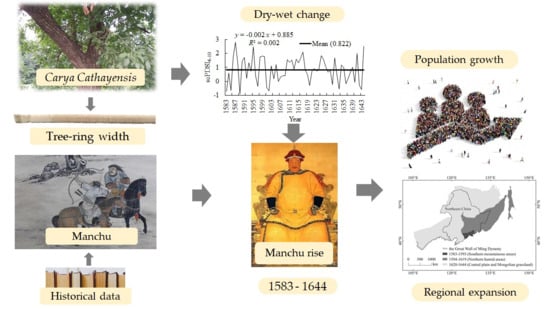
Graphical abstract
Open AccessArticle
Middle Holocene Subsistence in Southwestern Transylvania: Bioarchaeological Data on the Multicultural Site of Șoimuș-Teleghi (Hunedoara County, Romania)
by
Margareta Simina Stanc, Daniel Ioan Malaxa, Ioan Alexandru Bărbat, Antoniu Tudor Marc, Mariana Popovici, Luminița Bejenaru and Mihaela Danu
Quaternary 2025, 8(4), 60; https://doi.org/10.3390/quat8040060 - 23 Oct 2025
Abstract
►▼
Show Figures
This work proposes to contribute through an interdisciplinary perspective to the evaluation of paleoeconomic and paleoenvironmental changes during Middle Holocene in Southwestern Transylvania. The study integrates archaeozoological data with phytolith analysis to reconstruct subsistence and vegetation dynamics from the Early Neolithic to the
[...] Read more.
This work proposes to contribute through an interdisciplinary perspective to the evaluation of paleoeconomic and paleoenvironmental changes during Middle Holocene in Southwestern Transylvania. The study integrates archaeozoological data with phytolith analysis to reconstruct subsistence and vegetation dynamics from the Early Neolithic to the Late Bronze Age at Șoimuș-Teleghi (Hunedoara County, Romania). Animal remains are described in terms of their frequency (i.e., number of identified specimens and minimum number of individuals), taphonomic changes, and livestock management (i.e., animal selection by age and sex). Archaeozoological samples are dominated by skeletal remains from domestic mammals (e.g., cattle, sheep/goat, and pig), whose importance varies depending on the cultural level; the skeletal remains of wild mammals are less frequent, mainly belonging to species with large size (e.g., red deer, wild boar, roe deer, aurochs). This study tests whether animal exploitation strategies shifted from ruminant-dominated economies in the Neolithic to greater pig reliance in the Bronze Age, using the Shannon–Weaver diversity index and correspondence analysis. Phytolith analysis of eleven sediment samples from various cultural layers reveals the dominance of Pooideae-type grasses, with both vegetative plant parts and cereal inflorescences as resources. Bioarchaeological data presented in this study reveal a diachronic shift in subsistence practices, reflecting cultural and environmental transformations.
Full article
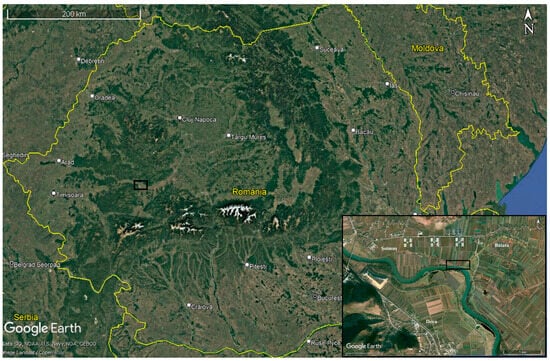
Figure 1
Open AccessArticle
Late Holocene Abrupt Changes in the Fluvial Dynamics of the Tiber Valley Catchment (Rome, Italy): An Impact of the 4.2 Event?
by
Fabrizio Marra, Carlo Rosa and Fabio Florindo
Quaternary 2025, 8(4), 59; https://doi.org/10.3390/quat8040059 - 23 Oct 2025
Abstract
►▼
Show Figures
In the present work, we investigate the post-glacial aggradation of three tributary valleys draining the left hydrographic basin of the Tiber River in central Rome: the Murcia, Caffarella, and Grottaperfetta valleys. We describe the Upper Pleistocene–Holocene stratigraphic record of the alluvial successions occurring
[...] Read more.
In the present work, we investigate the post-glacial aggradation of three tributary valleys draining the left hydrographic basin of the Tiber River in central Rome: the Murcia, Caffarella, and Grottaperfetta valleys. We describe the Upper Pleistocene–Holocene stratigraphic record of the alluvial successions occurring in the Caffarella Valley through the core data collected in a dedicatedly performed 35 m deep borehole. We provide seven 14C age constraints to the sediment aggradation which allow us to make a comparison with the Grottaperfetta and Murcia valleys, for which we present previously unpublished borehole data, and with the Tiber River Valley investigated in the previous literature. In particular, we highlight the effects of a mid-Holocene (5200–3800 yr BP) erosional phase, partially overlapping with the global 4.2 ka cooling/drying event, and we discuss the possible occurrence of a sea level fluctuation linked with this paleoclimatic event which has not been detected so far by other sedimentary records. Finally, we provide evidence for the widespread occurrence of a 6th century BCE (2550–2450 yr BP) overflooding phase that was previously observed only in the eastern portion of the Tiber River Valley in central Rome, which we suggest may be originated by concurrent intensive deforestation activity in central Italy.
Full article
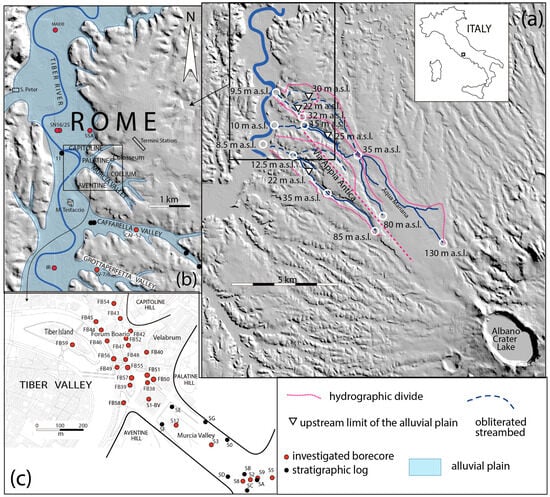
Figure 1
Open AccessArticle
The Late Glacial Advance of the James Lobe, South Dakota, Suggests Climate-Driven Laurentide Ice Sheet Behavior
by
Stephanie L. Heath and Thomas V. Lowell
Quaternary 2025, 8(4), 58; https://doi.org/10.3390/quat8040058 - 22 Oct 2025
Abstract
►▼
Show Figures
The relationship between climate and independent glacier masses is now understood, but what is not understood is how ice sheets respond during times of rapid climate change. At its maximum extent the southern Laurentide Ice Sheet (LIS) was sourced from two domes that
[...] Read more.
The relationship between climate and independent glacier masses is now understood, but what is not understood is how ice sheets respond during times of rapid climate change. At its maximum extent the southern Laurentide Ice Sheet (LIS) was sourced from two domes that terminated in multiple lobes across central North America. The extent and timing of the eastern lobes, which were sourced from the Labrador Dome are relatively well constrained. Although the extent of the lobes sourced from the western Keewatin Dome is better understood, there is little chronologic data on them. Twenty-six radiocarbon ages recovered from within the drift of the James Lobe from South Dakota are used to reconstruct the timing of late-glacial fluctuations of the James Lobe. Lithologic logs from 21 South Dakota counties were analyzed and provide stratigraphic context for the radiocarbon ages. Analysis of the stratigraphy reveals two distinct glacial till units with a distinct, widespread layer of silt between them. The silt is interpreted here as evidence for interstadial conditions between two separate advances of the James Lobe. Radiocarbon ages of organics from this silt layer and from within the uppermost oxidized till indicate that interstadial conditions persisted from ~15.8 to 13.7 ka, followed by an advance of the James Lobe of at least 230 km to its maximum position at the Missouri River. Comparison to other locations in Wisconsin, northern lower Michigan, and western New York reveals a similar period of interstadial conditions followed by ice margin advance. We correlate this advance across ~1000 km and suggest that the simplest explanation is reduced summer ablation caused by widespread climatic cooling.
Full article

Figure 1
Open AccessArticle
Microstructural Evolution of Antarctic Ice with the Rising Atmospheric CO2: A Longitudinal Meta-Analysis
by
Vuk Uskoković
Quaternary 2025, 8(4), 57; https://doi.org/10.3390/quat8040057 - 21 Oct 2025
Abstract
►▼
Show Figures
Antarctica, largely free from geopolitical borders, serves as a critical site for scientific research, environmental monitoring and climate studies. The continent’s ice cap holds over 60% of the Earth’s freshwater and provides a stable climatological record spanning 800,000 years. In this study, the
[...] Read more.
Antarctica, largely free from geopolitical borders, serves as a critical site for scientific research, environmental monitoring and climate studies. The continent’s ice cap holds over 60% of the Earth’s freshwater and provides a stable climatological record spanning 800,000 years. In this study, the relationship between changes in atmospheric CO2 levels over the past century and the microstructural characteristics of Antarctic ice was investigated. While it is well-documented that CO2 fluctuations have driven the periodic expansion and retreat of ice sheets, no research to this day has explored how variations in CO2 concentrations influence the physical integrity of ice at the microscopic scale. To address this, grain size, anisotropy, irregularity, and solidity of surface and near-surface ice samples collected over the past 70 years were analyzed. These microstructural features were compared against historical atmospheric greenhouse gas data from multiple Antarctic research stations, including records from the Scripps Institution of Oceanography, the Japanese Antarctic Research Expedition, and the NOAA Global Monitoring Laboratory. Results reveal a correlation between rising CO2 levels and changes in ice microstructure, particularly an increase in the grain size as well as the reduction in the grain aspect ratio and in the morphological solidity. The study remains limited by significant sources of variability, including differences in sampling depths, geographical locations, seasonal effects, and inconsistencies in analytical tools and methodologies reported across the literature. Despite these limitations, this proof-of-concept study elicits the need for continued meta-analyses of existing climate datasets. Such efforts could provide deeper insights into the role of greenhouse gas concentrations in defining the microstructural stability of Antarctic ice, which is critical for predicting ice sheet integrity and its contribution to sea level rise.
Full article

Figure 1
Open AccessArticle
Micro-Tomographic Investigation of a North-Western Pacific Polymetallic Nodule
by
Teddy Craciunescu, Octavian G. Duliu, Ion Tiseanu and Stefan A. Szobotka
Quaternary 2025, 8(4), 56; https://doi.org/10.3390/quat8040056 - 17 Oct 2025
Abstract
►▼
Show Figures
Micro-computed tomography (
Micro-computed tomography (

Figure 1
Open AccessArticle
Examination of Age-Depth Models Through Loess-Paleosol Sections in the Carpathian Basin
by
László Makó, Péter Cseh and Júlia Hupuczi
Quaternary 2025, 8(4), 55; https://doi.org/10.3390/quat8040055 - 15 Oct 2025
Abstract
►▼
Show Figures
The Carpathian Basin holds exceptional significance for Quaternary research, particularly in loess studies. In this study, we attempted to create age-depth models based on age data from scientific journals to investigate accumulation rates. We examined eleven open profile sections for loess and paleosol,
[...] Read more.
The Carpathian Basin holds exceptional significance for Quaternary research, particularly in loess studies. In this study, we attempted to create age-depth models based on age data from scientific journals to investigate accumulation rates. We examined eleven open profile sections for loess and paleosol, including seven in Hungary, two in Croatia, and two in Serbia. We demonstrated that radiocarbon age data are much more useful and reliable than OSL/IRSL data for this type of investigation. The results indicate that the Pécel, Dunaszekcső, Madaras and Katymár sections exhibit accumulation rates an order of magnitude higher than the other sections, exceeding one millimeter per year. These findings suggest that, owing to the basin’s geographic position, these areas were consistently exposed to dust deposition, irrespective of changes in climate or wind direction. A secondary accumulation maximum was also detected along the Katymár–Surduk axis, indicating an additional phase of intensified sediment deposition within this transect. The absence of a young sediment maximum in the Máza section is interpreted as resulting from a shift in prevailing wind direction, which caused the incoming dust to be intercepted by the Mecsek Mountains.
Full article

Figure 1
Open AccessArticle
Cooling Following the Magnetic Field Weakening During the Matuyama–Brunhes Transition Recorded by Paks Loess, Hungary
by
Balázs Bradák, Masayuki Hyodo and Erzsébet Horváth
Quaternary 2025, 8(4), 54; https://doi.org/10.3390/quat8040054 - 15 Oct 2025
Abstract
►▼
Show Figures
Detailed paleomagnetic and rock magnetic investigations of the Paks loess (Hungary) were conducted to determine the stratigraphic position of the Matuyama–Brunhes Transition (MBT) and to attempt to reveal the sign of any possible influences of geomagnetic field change on the climate during the
[...] Read more.
Detailed paleomagnetic and rock magnetic investigations of the Paks loess (Hungary) were conducted to determine the stratigraphic position of the Matuyama–Brunhes Transition (MBT) and to attempt to reveal the sign of any possible influences of geomagnetic field change on the climate during the geomagnetic polarity reversal. Progressive thermal and alternating field demagnetizations of samples showed that the reverse polarity field begins to fluctuate in a stratigraphic position of the well-developed, so-called Paks Double 2 (PD2) paleosol (formed in Marine Isotope Stage 19, MIS19), and continues up to the middle-to-upper part of the overlying paleosol-to-loess transition layer (MIS19 to 18). Considering the relative paleointensity variation from Paks, this is consistent with various global records. Along with the weakening of the geomagnetic field, changes in environmental proxies were also recognized. Magnetic proxies indicate cooling during the MIS19 interglacial period. Theoretically, it may be connected to the weakening of the geomagnetic field. Still, there are alternatives to be considered, which may form the same features thought to be the result of the Umbrella effect.
Full article
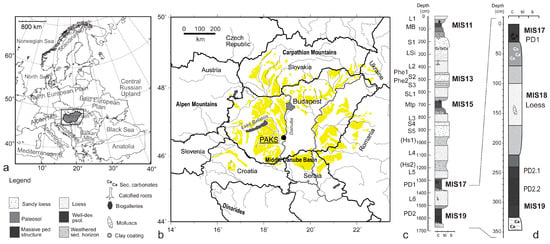
Figure 1
Open AccessArticle
Paleobiodiversity and Paleoecology Insights from a New MIS 5e Highstand Deposit on Santa Maria Island (Azores Archipelago, Portugal)
by
Sergio Moreno, Mohamed Amine Doukani, Ana Hipólito, Patrícia Madeira, Sergio Pérez Pérez, Laura S. Dalmau, Gonçalo Castela Ávila, Luís Silva, Gustavo M. Martins, Esther Martín-González, Markes E. Johnson and Sérgio P. Ávila
Quaternary 2025, 8(4), 53; https://doi.org/10.3390/quat8040053 - 30 Sep 2025
Abstract
►▼
Show Figures
During the last two decades, the Macaronesian archipelagos have been the focus of multiple studies targeting the abundant and diversified fossil record from late Neogene and Quaternary deposits. This record of past biota, ecosystems and climates is crucial for understanding the impact of
[...] Read more.
During the last two decades, the Macaronesian archipelagos have been the focus of multiple studies targeting the abundant and diversified fossil record from late Neogene and Quaternary deposits. This record of past biota, ecosystems and climates is crucial for understanding the impact of glacial–interglacial cycles on Atlantic littoral marine organisms. Coupled with ongoing studies on the factors responsible for global climate change and associated sea-level variations, they contributed decisively towards the development of the modern marine island biogeography theory. Our current knowledge of the evolutionary and biogeographic history of the past and extant, shallow-water marine organisms from the Macaronesian geographic region relies on detailed analysis of many individual fossiliferous outcrops by means of quantitative and qualitative methodologies. Here, we focus on the fossil record of a newly studied MIS 5e outcrop at Pedra-que-pica (PQP), on Santa Maria Island (Azores Archipelago, Portugal). This multidisciplinary work integrates geology, paleontology and biology, providing the first detailed description of the sedimentary facies and stratigraphic framework of the PQP MIS 5e sequence that, coupled with the documentation of the biodiversity and ecological composition of PQP molluscan assemblages, allows us to produce a paleoecological reconstruction and to compare PQP with other last interglacial outcrops from Santa Maria Island. Our results increase the number of the Azorean MIS 5e marine molluscs to 140 taxa (116 Gastropoda and 24 Bivalvia). Ervilia castanea (Montagu, 1803) is the most abundant bivalve, while Bittium nanum (Mayer, 1864) and Melarhaphe neritoides (Linnaeus, 1758) are the most abundant gastropod species. In addition, this work emphasizes the crucial importance of complementing quantitative collecting with qualitative surveys of the fossiliferous outcrops, because nearly 42% of the bivalve species and 28% of the gastropod taxa would be missed if only quantitative samples were used. Derivation of Hill numbers and rarefaction curves both indicate that the sampling effort should be increased at PQP. Thus, although Santa Maria Island is recognized by the scientific community as one of the best-studied islands regarding the last interglacial fossil record, this study emphasizes the need to continue with similar efforts in less known outcrops on the island.
Full article

Figure 1
Open AccessArticle
Middle Paleolithic Neanderthal Open-Air Camp and Hyena Den Westeregeln (D)—Competition for Prey in a Mammoth Steppe Environment of Northern Germany (Central Europe)
by
Cajus G. Diedrich
Quaternary 2025, 8(4), 52; https://doi.org/10.3390/quat8040052 - 24 Sep 2025
Abstract
A gypsum karst sinkhole at Westeregeln (north-central Germany) was filled during the Late Pleistocene, first by fluvial flooding, then by solifluctation, and finally with wind-transported loess. Pleistocene mollusks and bones of snakes, birds, micro- and macromammals, and hyena coprolites were accumulated, often mixed
[...] Read more.
A gypsum karst sinkhole at Westeregeln (north-central Germany) was filled during the Late Pleistocene, first by fluvial flooding, then by solifluctation, and finally with wind-transported loess. Pleistocene mollusks and bones of snakes, birds, micro- and macromammals, and hyena coprolites were accumulated, often mixed in gravel or sand layers with Middle Paleolithic artifacts, whereas ice wedges reach deep into the sinkhole. The high amount of small flint debris prove on-site tool production by using 99% local Saalian transported brownish-to-dark Upper Cretaceous flint, which could have been collected from the Bode River gravels near-site. Only a single quartzite and one jasper flake prove other local gravel sources or importation. A large bifacial flaked knife of layer 4 dates to the early/middle Weichselian/Wuermian (MIS 5-4), similar to two triangular handaxes in the MTA tradition and an absolutely dated woolly rhinoceros bone (50,310 + 1580/−1320 BP). A cold period of Late Pleistocene glacial mammoth steppe megafauna is represented, but the material is mostly strongly fragmented and smashed by humans. Neanderthal camp use on the gypsum hill is indicated also by small charcoal pieces, burned bone fragments, and fire-dehydrated flint fragments. Crocuta crocuta spelaea (Goldfuss) hyenas are well known from Westeregeln, with an open-air commuting den site, which was marked with feces.
Full article
(This article belongs to the Special Issue Archaeology in the Late Quaternary: Emerging Materials, Methods, Issues and Perspectives)
►▼
Show Figures

Figure 1
Highly Accessed Articles
Latest Books
E-Mail Alert
News
Topics
Topic in
GeoHazards, Geosciences, Quaternary, Remote Sensing
Geomorphological Processes of Continental Landscapes in Tectonically Active Areas
Topic Editors: Stefano Pucci, Daniela PantostiDeadline: 31 December 2025

Special Issues
Special Issue in
Quaternary
Quaternary Birds of the Planet of First, Ancient and Modern Humans
Guest Editor: Zlatozar BoevDeadline: 10 December 2025
Special Issue in
Quaternary
From Source to Sink: Sedimentary Archives and Its Palaeo-Environmental Implications During Quaternary
Guest Editor: Yan LiDeadline: 31 December 2025
Special Issue in
Quaternary
Paleoecology, Evolution, Biogeography and Systematics of Quaternary Mammals
Guest Editors: H. Gregory McDonald, Joaquín Arroyo-CabralesDeadline: 10 January 2026
Special Issue in
Quaternary
Interdisciplinary Research into Cultural and Biological Transformations in the Paleolithic Period: 2nd Edition
Guest Editor: Ran BarkaiDeadline: 20 February 2026
Topical Collections
Topical Collection in
Quaternary
Exclusive Collection: Papers from the Editorial Board Members (EBMs) of Quaternary
Collection Editor: Valentí Rull
Topical Collection in
Quaternary
Feature Papers in Quaternary Research
Collection Editors: Jef Vandenberghe, Valentí Rull


